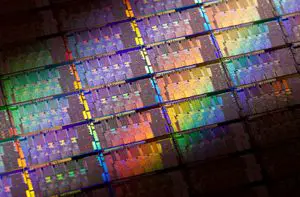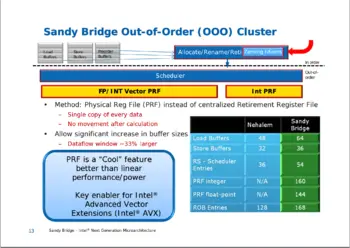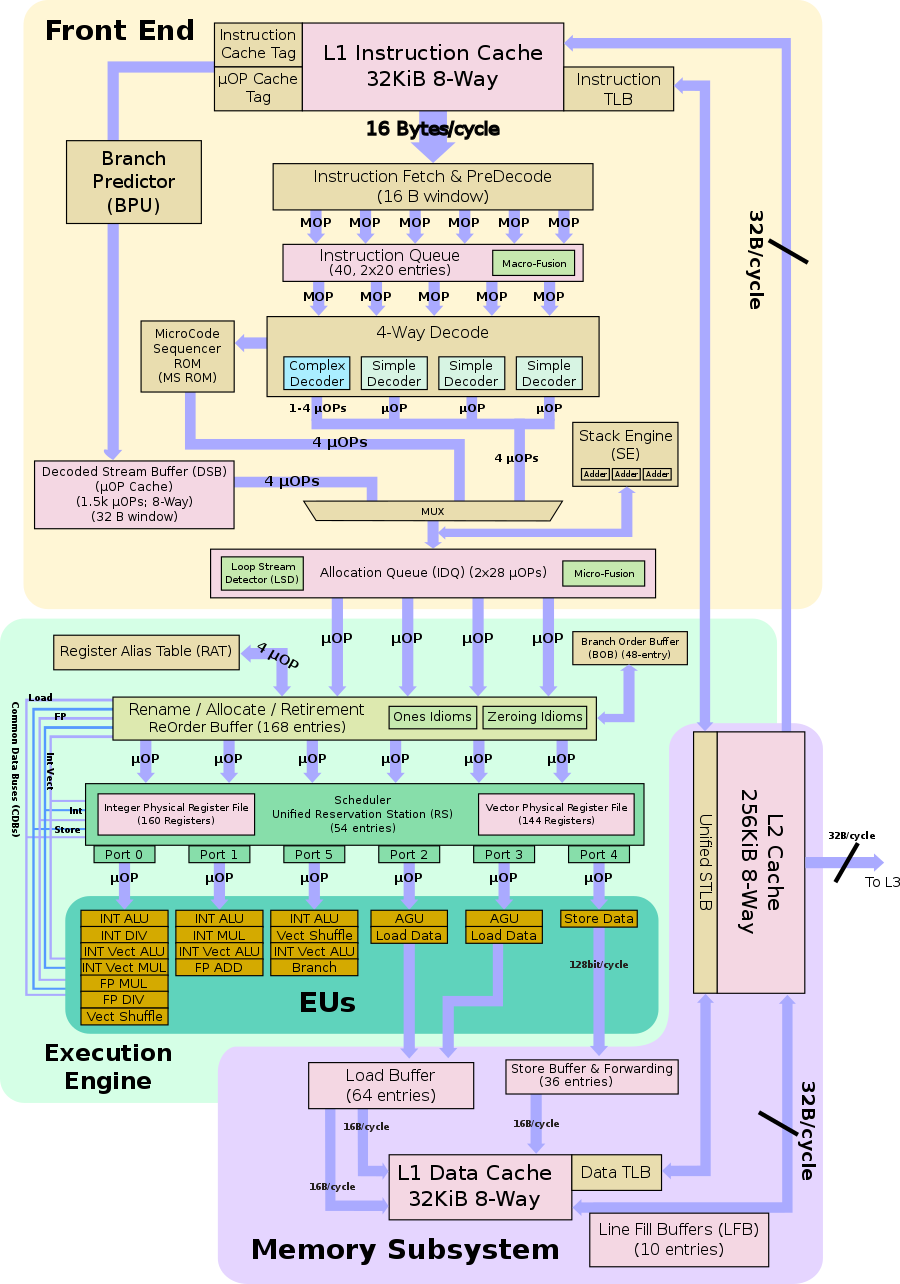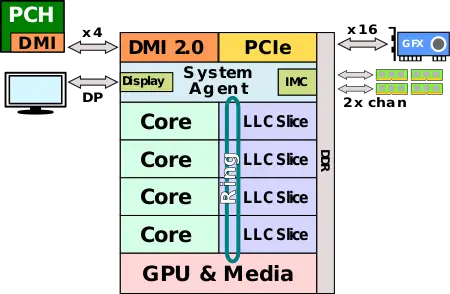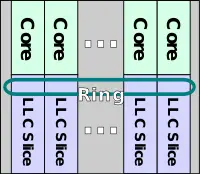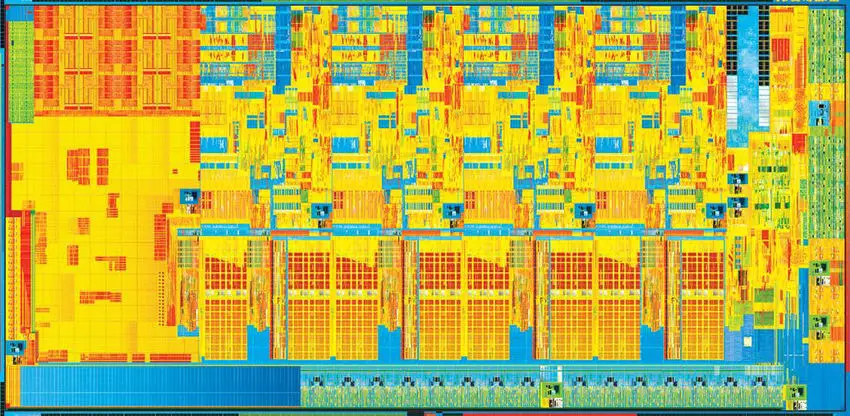| Edit Values | |
| Sandy Bridge (client) µarch | |
| General Info | |
| Arch Type | CPU |
| Designer | Intel |
| Manufacturer | Intel |
| Introduction | September 13, 2010 |
| Phase-out | November, 2012 |
| Process | 32 nm |
| Core Configs | 2, 4 |
| Pipeline | |
| Type | Superscalar, Superpipeline |
| OoOE | Yes |
| Speculative | Yes |
| Reg Renaming | Yes |
| Stages | 14-19 |
| Decode | 4-way |
| Instructions | |
| ISA | x86-16, x86-32, x86-64 |
| Succession | |
| Contemporary | |
| Sandy Bridge (server) | |
Sandy Bridge (SNB) Client Configuration, formerly Gesher, is Intel's successor to Nehalem, a 32 nm process microarchitecture for mainstream workstations, desktops, and mobile devices. Sandy Bridge is the "Tock" phase as part of Intel's Tick-Tock model which added a significant number of enhancements and features. The microarchitecture was developed by Intel's R&D center in Haifa, Israel.
For desktop and mobile, Sandy Bridge is branded as 2nd Generation Intel Core i3, Core i5, Core i7 processors. For workstations it's branded as first generation Xeon E3.
Contents
Etymology
Sandy Bridge was originally called Gesher which literally means "bridge" in Hebrew. The name was requested to be changed by upper management after a meeting between the development group and analysts brought up that it might be a bad idea to be associated with a failed political party that was eventually dissolved.
The name Sandy Bridge consists of the English translation of "Gesher" with "Sandy" possible referring to the fact that silicon comes from sand.
The Logo on the left was Intel's original ("Gesher") logo for the microarchitecture.
Codenames
| This section is empty; you can help add the missing info by editing this page. |
Process Technology
- Main article: Westmere § Process Technology
Sandy Bridge uses the same 32 nm process used for the Westmere microarchitecture for all mainstream consumer parts.
Architecture
Sandy Bridge's features an entirely new architecture with a brand new core design which is both more performent and more power efficient. Sandy Bridge provides considerable higher integration verses its predecessors.
Key changes from Westmere
- Entirely brand new microarchitecture
- Chipset
- Ibex Peak → Cougar Point
- Socket H (LGA-1156) → Socket H2 (LGA-1155)
- Integrated Graphics
- Integrated graphics is now integrated on the same die (previously was on a second die)
- Dropped QPI controller which linked the two dies
- IMC
- Integrated on-die is now integrated on the same die (previously was on a second die)
- Dropped QPI controller which linked the two dies
| This section requires expansion; you can help adding the missing info. |
Block Diagram
Individual Core
Overview
Sandy Bridge was an entirely new microarchitecture which combines some of the improvements that were implemented in NetBurst along with the original P6 design. In addition to the new core design, Sandy Bridge took full advantage of Intel's 32 nm process which enabled the integration all the components of the chip on a single monolithic die, including the integrated graphics and the integrated memory controller. Sandy Bridge is the first Intel microarchitecture designed as a true system on a chip for high-volume client mainstream market. Previously (e.g., Nehalem) the integrated graphics and the memory interface were fabricated on a separate die which was packaged together and communicated over Intel's QuickPath Interconnect (QPI). The seperate dies were then packaged together as a system on a package.
As stated earlier, the individual cores are an entirely new design which improved both performance and power. Sandy Bridge introduced a number of performance features that brought better-than-linear performance/power as well as a number of enhancements that improved performance while saving power. Intel introduced a number of new vector computation (SIMD) and security instructions which improved floating point performance and throughput as well as speedup the throughput of various encryption algorithms. Sandy Bridge incorporates either two or four physical cores with either four or eight logical cores.
The block diagram on the right is a complete quad-core Sandy Bridge SoC which integrates the new System Agent (SA), the four physical cores along with their companion last level cache (LLC) slices, and the integrated graphics. Interconnecting everything is a complex high-bandwidth low-latency ring on-die which consists of six agents - one for each core and cache slice, one for the system agent, and one for the graphics. The upper portion of the diagram is the System Agent (SA) which incorporates the display controller, the memory controller, and the various I/O interfaces. Previously that component was referred to as the Memory Controller Hub (MCH) when on a separate die. Sandy Bridge incorporates 20 PCIe 2.0 lanes - x4 are used by the DMI with the other x16 lanes designed for a dedicated GPU. The memory controller supports up to dual-channel DDR3-1600 (depending on model).
System Architecture
Sandy Bridge was designed with configurability (i.e. modularity) scalability as the primary system goals. With the full integration of the graphics and memory controller hub on-die Intel needed a new way to efficiently interconnect all the individual components. Modularity was a major design goal for Sandy Bridge. Intel wanted to be able to design the cores and the graphics independently of the rest of the system and be able to detach the graphics and added more cores as desired.
The scalability goal was important for Intel's server configuration where the graphics are dropped and more cores can be added to the ring without compromising performance. Sandy Bridge comprised of a fairly robust ring implementation with bandwidth that can scale to more cores as necessary.
Cache Architecture
As part of the entire system overhaul, the cache architecture has been streamlined and more scalable. Sandy Bridge features a high-bandwidth last level cache which is shared by all the cores as well as the integrated graphics and the system agent. The LLC is an inclusive multi-bank cache architecture that is tightly associative with the individual cores. Each core is paired with a "slice" of LLC which is 2 MiB in size (lower amount for lower-end models). This pairing of cores and cache slices scales with the number of cores which provides a significant performance boost while saving power and bandwidth. Partitioning the data also helps simplifies coherency as well as reduce localized contentions and hot spots.
The last level cache is an inclusive cache with a 64 byte cache line organized as 16-way set associative. Each LLC slice is accessible to all cores. With up to 2 MiB per slice per core, a four-core model will sport a total of 8 MiB. Lower-end/budget models feature a smaller cache slice. This is done by disabling ways of cache in 4-way increments (for a granularity of 512 KiB). The LLC to use latency in Sandy Bridge has been greatly improved from 35-40+ in Nehalem to 26-31 cycles (depending on ring hops).
Cache Box
Within each cache slice is cache box. The cache box is the controller and agent serving as the interface between the LLC and the rest of the system (i.e., cores, graphics, and system agent). The cache box implements the ring logic and the address hashing and arbitration. It is also tasked with communicating with the System Agent on cache misses, non-cacheable accesses (such as in the case of I/O pulls), as well as external I/O snoop requests. The cache box is fully pipelined and is capable of working on multiple requests at the same time. Agent requests (e.g., ones from the GPU) are handled by the individual cache boxes via the ring. This is much different to how it was previously done in Westmere where a single unified cache handled everything. The distribution of slices allows Sandy Bridge to have higher associativity bandwidth while reducing traffic.
The entire physical address space is mapped distributively across all the slices using a hash function. On a miss, the core needs decodes the address to figure out which slice ID to request the data from. Physical addresses are hashed at the source in order to prevent hot spots. The cache box is responsible for the maintaining of coherency and ordering between requests. Because the LLC slices are fully inclusive, it can make efficienct use of an on-die snoop filter. Each slice makes use of Core Valid Bits (CVB) which is used to eliminate unnecessary snoops to the cores. A single bit per cache line is needed to indicate if the line may be in the core. Snoops are therefore only needed if the line is in the LLC and a CVB is asserted on that line. This mechanism helps limits external snoops to the cache box most of the time without resorting to going to the cores.
Note that both the cache slices and the cache boxes reside within the same clock domain as the cores themselves - sharing the same voltage and frequency and scaling along with the cores when needed.
Ring Interconnect
In the pursuit of modularity, Sandy Bridge incorporates a new and robust high-bandwidth coherent interconnect that links all the separate components together. The ring is a system of interconnects between the cores, the graphics, the last level cache, and the System Agent. The ring allows Intel to scale up and down efficiently depending on the market segmentation which allows for finer balance of performance, power, and cost.
Internally, the ring is composed of four physical independent rings:
- 32-byte Data ring
- Request ring
- Acknowledge ring
- Snoop ring
The four rings consists of a considerable amount of wiring and routing. Because the routing runs in a separate layer over the LLC, the rings have no real impact on die area. As with the LLC slices, the ring is fully pipelined and operates within the core's clock domain as it scales with frequency.
It's important to note that the term ring refers to its structure and not necessarily how the data flows. The ring is not a round-robin and requests may travel up or down as needed. In order reduce latency, the ring is designed such as that all accesses on the ring always picks the shortest path. Because of this aspect of the ring and the fact that some requests can take longer than others to complete, the ring might have requests being handled out of order. It is the responsibility of the source agents to handle the ordering requirements. The ring cache coherency protocol is largely based on Intel's QPI protocols with MESI-based source snooping protocol.
Core
Sandy Bridge can be considered the first brand new microarchitecture since the introduction of NetBurst and P6 prior. Sandy Bridge went back to the drawing board and incorporated many of beneficial elements from P6 as well as NetBurst. While NetBurst ended up being a seriously flawed architecture, its design was driven by a number of key innovations which were re-implemented and enhanced in Sandy Bridge. This is different from earlier architectures (i.e., Core through Nehalem) which were almost exclusively enhancements of P6 with nothing inherited from P4. Every aspect of the core was improved over its predecessors with very functional block being improved.
| This section requires expansion; you can help adding the missing info. |
Die
Quad-core Sandy Bridge die:
- 1,160,000,000 transistors
- 32 nm process
- 216 mm2
- 4 CPU cores
- 1 GPU core
- 12 EUs
Cores
| This section is empty; you can help add the missing info by editing this page. |
All Sandy Bridge Chips
... further results| Sandy Bridge Chips | |||||||||||
|---|---|---|---|---|---|---|---|---|---|---|---|
| Main processor | IGP | ||||||||||
| Model | µarch | Platform | Core | Launched | SDP | TDP | Freq | Max Mem | Name | Freq | Max Freq |
| 787 | Sandy Bridge | Sandy Bridge M | Sandy Bridge M | July 2011 | 17 W 17,000 mW 0.0228 hp 0.017 kW | 1,300 MHz 1.3 GHz 1,300,000 kHz | 16,384 MiB 16,777,216 KiB 17,179,869,184 B 16 GiB 0.0156 TiB | HD Graphics (Sandy Bridge) | 350 MHz 0.35 GHz 350,000 KHz | 950 MHz 0.95 GHz 950,000 KHz | |
| 797 | Sandy Bridge | Sandy Bridge M | Sandy Bridge M | January 2012 | 17 W 17,000 mW 0.0228 hp 0.017 kW | 1,400 MHz 1.4 GHz 1,400,000 kHz | 16,384 MiB 16,777,216 KiB 17,179,869,184 B 16 GiB 0.0156 TiB | HD Graphics (Sandy Bridge) | 350 MHz 0.35 GHz 350,000 KHz | 950 MHz 0.95 GHz 950,000 KHz | |
| 807 | Sandy Bridge | Sandy Bridge M | Sandy Bridge M | July 2012 | 17 W 17,000 mW 0.0228 hp 0.017 kW | 1,500 MHz 1.5 GHz 1,500,000 kHz | 16,384 MiB 16,777,216 KiB 17,179,869,184 B 16 GiB 0.0156 TiB | HD Graphics (Sandy Bridge) | 350 MHz 0.35 GHz 350,000 KHz | 950 MHz 0.95 GHz 950,000 KHz | |
| 807UE | Sandy Bridge | Sandy Bridge M | Sandy Bridge M | July 2012 | 10 W 10,000 mW 0.0134 hp 0.01 kW | 1,000 MHz 1 GHz 1,000,000 kHz | 4,096 MiB 4,194,304 KiB 4,294,967,296 B 4 GiB 0.00391 TiB | HD Graphics (Sandy Bridge) | 350 MHz 0.35 GHz 350,000 KHz | 800 MHz 0.8 GHz 800,000 KHz | |
| 817 | Sandy Bridge | Sandy Bridge M | Sandy Bridge M | 2012 | 17 W 17,000 mW 0.0228 hp 0.017 kW | 1,600 MHz 1.6 GHz 1,600,000 kHz | 16,384 MiB 16,777,216 KiB 17,179,869,184 B 16 GiB 0.0156 TiB | HD Graphics (Sandy Bridge) | 350 MHz 0.35 GHz 350,000 KHz | 800 MHz 0.8 GHz 800,000 KHz | |
| 827 | Sandy Bridge | Sandy Bridge M | Sandy Bridge M | 2012 | 17 W 17,000 mW 0.0228 hp 0.017 kW | 1,400 MHz 1.4 GHz 1,400,000 kHz | 16,384 MiB 16,777,216 KiB 17,179,869,184 B 16 GiB 0.0156 TiB | HD Graphics (Sandy Bridge) | 350 MHz 0.35 GHz 350,000 KHz | 800 MHz 0.8 GHz 800,000 KHz | |
| 827E | Sandy Bridge | Sandy Bridge M | Sandy Bridge M | July 2011 | 17 W 17,000 mW 0.0228 hp 0.017 kW | 1,400 MHz 1.4 GHz 1,400,000 kHz | 16,384 MiB 16,777,216 KiB 17,179,869,184 B 16 GiB 0.0156 TiB | HD Graphics (Sandy Bridge) | 350 MHz 0.35 GHz 350,000 KHz | 800 MHz 0.8 GHz 800,000 KHz | |
| 837 | Sandy Bridge | Sandy Bridge M | Sandy Bridge M | 2012 | 17 W 17,000 mW 0.0228 hp 0.017 kW | 1,800 MHz 1.8 GHz 1,800,000 kHz | 16,384 MiB 16,777,216 KiB 17,179,869,184 B 16 GiB 0.0156 TiB | HD Graphics (Sandy Bridge) | 350 MHz 0.35 GHz 350,000 KHz | 800 MHz 0.8 GHz 800,000 KHz | |
| 847 | Sandy Bridge | Sandy Bridge M | Sandy Bridge M | June 2011 | 17 W 17,000 mW 0.0228 hp 0.017 kW | 1,100 MHz 1.1 GHz 1,100,000 kHz | 16,384 MiB 16,777,216 KiB 17,179,869,184 B 16 GiB 0.0156 TiB | HD Graphics (Sandy Bridge) | 350 MHz 0.35 GHz 350,000 KHz | 800 MHz 0.8 GHz 800,000 KHz | |
| 847E | Sandy Bridge | Sandy Bridge M | Sandy Bridge M | June 2011 | 17 W 17,000 mW 0.0228 hp 0.017 kW | 1,100 MHz 1.1 GHz 1,100,000 kHz | 16,384 MiB 16,777,216 KiB 17,179,869,184 B 16 GiB 0.0156 TiB | HD Graphics (Sandy Bridge) | 350 MHz 0.35 GHz 350,000 KHz | 800 MHz 0.8 GHz 800,000 KHz | |
| 857 | Sandy Bridge | Sandy Bridge M | Sandy Bridge M | July 2011 | 17 W 17,000 mW 0.0228 hp 0.017 kW | 1,200 MHz 1.2 GHz 1,200,000 kHz | 16,384 MiB 16,777,216 KiB 17,179,869,184 B 16 GiB 0.0156 TiB | HD Graphics (Sandy Bridge) | 350 MHz 0.35 GHz 350,000 KHz | 1,000 MHz 1 GHz 1,000,000 KHz | |
| 867 | Sandy Bridge | Sandy Bridge M | Sandy Bridge M | January 2012 | 17 W 17,000 mW 0.0228 hp 0.017 kW | 1,300 MHz 1.3 GHz 1,300,000 kHz | 16,384 MiB 16,777,216 KiB 17,179,869,184 B 16 GiB 0.0156 TiB | HD Graphics (Sandy Bridge) | 350 MHz 0.35 GHz 350,000 KHz | 1,000 MHz 1 GHz 1,000,000 KHz | |
| 877 | Sandy Bridge | Sandy Bridge M | Sandy Bridge M | July 2012 | 17 W 17,000 mW 0.0228 hp 0.017 kW | 1,400 MHz 1.4 GHz 1,400,000 kHz | 16,384 MiB 16,777,216 KiB 17,179,869,184 B 16 GiB 0.0156 TiB | HD Graphics (Sandy Bridge) | 350 MHz 0.35 GHz 350,000 KHz | 1,000 MHz 1 GHz 1,000,000 KHz | |
| 887 | Sandy Bridge | Sandy Bridge M | Sandy Bridge M | September 2012 | 17 W 17,000 mW 0.0228 hp 0.017 kW | 1,500 MHz 1.5 GHz 1,500,000 kHz | 16,384 MiB 16,777,216 KiB 17,179,869,184 B 16 GiB 0.0156 TiB | HD Graphics (Sandy Bridge) | 350 MHz 0.35 GHz 350,000 KHz | 1,000 MHz 1 GHz 1,000,000 KHz | |
| 887E | Sandy Bridge | Sandy Bridge M | Sandy Bridge M | September 2012 | 17 W 17,000 mW 0.0228 hp 0.017 kW | 1,500 MHz 1.5 GHz 1,500,000 kHz | 16,384 MiB 16,777,216 KiB 17,179,869,184 B 16 GiB 0.0156 TiB | HD Graphics (Sandy Bridge) | 350 MHz 0.35 GHz 350,000 KHz | 1,000 MHz 1 GHz 1,000,000 KHz | |
| 897 | Sandy Bridge | Sandy Bridge M | Sandy Bridge M | 2012 | 17 W 17,000 mW 0.0228 hp 0.017 kW | 1,600 MHz 1.6 GHz 1,600,000 kHz | 16,384 MiB 16,777,216 KiB 17,179,869,184 B 16 GiB 0.0156 TiB | HD Graphics (Sandy Bridge) | 350 MHz 0.35 GHz 350,000 KHz | 1,000 MHz 1 GHz 1,000,000 KHz | |
| B710 | Sandy Bridge | Sandy Bridge M | Sandy Bridge M | June 2011 | 35 W 35,000 mW 0.0469 hp 0.035 kW | 1,600 MHz 1.6 GHz 1,600,000 kHz | 16,384 MiB 16,777,216 KiB 17,179,869,184 B 16 GiB 0.0156 TiB | HD Graphics (Sandy Bridge) | 650 MHz 0.65 GHz 650,000 KHz | 1,000 MHz 1 GHz 1,000,000 KHz | |
| B720 | Sandy Bridge | Sandy Bridge M | Sandy Bridge M | January 2012 | 35 W 35,000 mW 0.0469 hp 0.035 kW | 1,700 MHz 1.7 GHz 1,700,000 kHz | 16,384 MiB 16,777,216 KiB 17,179,869,184 B 16 GiB 0.0156 TiB | HD Graphics (Sandy Bridge) | 650 MHz 0.65 GHz 650,000 KHz | 1,000 MHz 1 GHz 1,000,000 KHz | |
| B730 | Sandy Bridge | Sandy Bridge M | Sandy Bridge M | July 2012 | 35 W 35,000 mW 0.0469 hp 0.035 kW | 1,800 MHz 1.8 GHz 1,800,000 kHz | 16,384 MiB 16,777,216 KiB 17,179,869,184 B 16 GiB 0.0156 TiB | HD Graphics (Sandy Bridge) | 650 MHz 0.65 GHz 650,000 KHz | 1,000 MHz 1 GHz 1,000,000 KHz | |
| B800 | Sandy Bridge | Sandy Bridge M | Sandy Bridge M | June 2011 | 35 W 35,000 mW 0.0469 hp 0.035 kW | 1,500 MHz 1.5 GHz 1,500,000 kHz | 16,384 MiB 16,777,216 KiB 17,179,869,184 B 16 GiB 0.0156 TiB | HD Graphics (Sandy Bridge) | 650 MHz 0.65 GHz 650,000 KHz | 1,000 MHz 1 GHz 1,000,000 KHz | |
| B810 | Sandy Bridge | Sandy Bridge M | Sandy Bridge M | 14 March 2011 | 35 W 35,000 mW 0.0469 hp 0.035 kW | 1,600 MHz 1.6 GHz 1,600,000 kHz | 16,384 MiB 16,777,216 KiB 17,179,869,184 B 16 GiB 0.0156 TiB | HD Graphics (Sandy Bridge) | 650 MHz 0.65 GHz 650,000 KHz | 950 MHz 0.95 GHz 950,000 KHz | |
| B810E | Sandy Bridge | Sandy Bridge M | Sandy Bridge M | June 2011 | 35 W 35,000 mW 0.0469 hp 0.035 kW | 1,600 MHz 1.6 GHz 1,600,000 kHz | 16,384 MiB 16,777,216 KiB 17,179,869,184 B 16 GiB 0.0156 TiB | HD Graphics (Sandy Bridge) | 650 MHz 0.65 GHz 650,000 KHz | 1,000 MHz 1 GHz 1,000,000 KHz | |
| B815 | Sandy Bridge | Sandy Bridge M | Sandy Bridge M | January 2012 | 35 W 35,000 mW 0.0469 hp 0.035 kW | 1,600 MHz 1.6 GHz 1,600,000 kHz | 16,384 MiB 16,777,216 KiB 17,179,869,184 B 16 GiB 0.0156 TiB | HD Graphics (Sandy Bridge) | 650 MHz 0.65 GHz 650,000 KHz | 1,050 MHz 1.05 GHz 1,050,000 KHz | |
| B820 | Sandy Bridge | Sandy Bridge M | Sandy Bridge M | July 2012 | 35 W 35,000 mW 0.0469 hp 0.035 kW | 1,700 MHz 1.7 GHz 1,700,000 kHz | 16,384 MiB 16,777,216 KiB 17,179,869,184 B 16 GiB 0.0156 TiB | HD Graphics (Sandy Bridge) | 650 MHz 0.65 GHz 650,000 KHz | 1,050 MHz 1.05 GHz 1,050,000 KHz | |
| B830 | Sandy Bridge | Sandy Bridge M | Sandy Bridge M | July 2011 | 35 W 35,000 mW 0.0469 hp 0.035 kW | 1,800 MHz 1.8 GHz 1,800,000 kHz | 16,384 MiB 16,777,216 KiB 17,179,869,184 B 16 GiB 0.0156 TiB | HD Graphics (Sandy Bridge) | 650 MHz 0.65 GHz 650,000 KHz | 1,050 MHz 1.05 GHz 1,050,000 KHz | |
| B840 | Sandy Bridge | Sandy Bridge M | Sandy Bridge M | July 2011 | 35 W 35,000 mW 0.0469 hp 0.035 kW | 1,900 MHz 1.9 GHz 1,900,000 kHz | 16,384 MiB 16,777,216 KiB 17,179,869,184 B 16 GiB 0.0156 TiB | HD Graphics (Sandy Bridge) | 650 MHz 0.65 GHz 650,000 KHz | 1,000 MHz 1 GHz 1,000,000 KHz | |
| B860E | Sandy Bridge | Sandy Bridge M | Sandy Bridge M | 2012 | 35 W 35,000 mW 0.0469 hp 0.035 kW | 2,100 MHz 2.1 GHz 2,100,000 kHz | 16,384 MiB 16,777,216 KiB 17,179,869,184 B 16 GiB 0.0156 TiB | HD Graphics (Sandy Bridge) | 650 MHz 0.65 GHz 650,000 KHz | 1,000 MHz 1 GHz 1,000,000 KHz | |
| i3-2308M | Sandy Bridge | Sandy Bridge M | Sandy Bridge M | February 2011 | 35 W 35,000 mW 0.0469 hp 0.035 kW | 2,100 MHz 2.1 GHz 2,100,000 kHz | 16,384 MiB 16,777,216 KiB 17,179,869,184 B 16 GiB 0.0156 TiB | HD Graphics 3000 | 650 MHz 0.65 GHz 650,000 KHz | 1,100 MHz 1.1 GHz 1,100,000 KHz | |
| i3-2310E | Sandy Bridge | Sandy Bridge M | Sandy Bridge M | February 2011 | 35 W 35,000 mW 0.0469 hp 0.035 kW | 2,100 MHz 2.1 GHz 2,100,000 kHz | 16,384 MiB 16,777,216 KiB 17,179,869,184 B 16 GiB 0.0156 TiB | HD Graphics 3000 | 650 MHz 0.65 GHz 650,000 KHz | 1,050 MHz 1.05 GHz 1,050,000 KHz | |
| i3-2310M | Sandy Bridge | Sandy Bridge M | Sandy Bridge M | February 2011 | 35 W 35,000 mW 0.0469 hp 0.035 kW | 2,100 MHz 2.1 GHz 2,100,000 kHz | 16,384 MiB 16,777,216 KiB 17,179,869,184 B 16 GiB 0.0156 TiB | HD Graphics 3000 | 650 MHz 0.65 GHz 650,000 KHz | 1,100 MHz 1.1 GHz 1,100,000 KHz | |
| i3-2312M | Sandy Bridge | Sandy Bridge M | Sandy Bridge M | June 2011 | 35 W 35,000 mW 0.0469 hp 0.035 kW | 2,100 MHz 2.1 GHz 2,100,000 kHz | 16,384 MiB 16,777,216 KiB 17,179,869,184 B 16 GiB 0.0156 TiB | HD Graphics 3000 | 650 MHz 0.65 GHz 650,000 KHz | 1,100 MHz 1.1 GHz 1,100,000 KHz | |
| i3-2328M | Sandy Bridge | Sandy Bridge M | Sandy Bridge M | September 2012 | 35 W 35,000 mW 0.0469 hp 0.035 kW | 2,200 MHz 2.2 GHz 2,200,000 kHz | 16,384 MiB 16,777,216 KiB 17,179,869,184 B 16 GiB 0.0156 TiB | HD Graphics 3000 | 650 MHz 0.65 GHz 650,000 KHz | 1,100 MHz 1.1 GHz 1,100,000 KHz | |
| i3-2330E | Sandy Bridge | Sandy Bridge M | Sandy Bridge M | June 2011 | 35 W 35,000 mW 0.0469 hp 0.035 kW | 2,200 MHz 2.2 GHz 2,200,000 kHz | 16,384 MiB 16,777,216 KiB 17,179,869,184 B 16 GiB 0.0156 TiB | HD Graphics 3000 | 650 MHz 0.65 GHz 650,000 KHz | 1,050 MHz 1.05 GHz 1,050,000 KHz | |
| i3-2330M | Sandy Bridge | Sandy Bridge M | Sandy Bridge M | June 2011 | 35 W 35,000 mW 0.0469 hp 0.035 kW | 2,200 MHz 2.2 GHz 2,200,000 kHz | 16,384 MiB 16,777,216 KiB 17,179,869,184 B 16 GiB 0.0156 TiB | HD Graphics 3000 | 650 MHz 0.65 GHz 650,000 KHz | 1,100 MHz 1.1 GHz 1,100,000 KHz | |
| i3-2332M | Sandy Bridge | Sandy Bridge M | Sandy Bridge M | September 2011 | 35 W 35,000 mW 0.0469 hp 0.035 kW | 2,200 MHz 2.2 GHz 2,200,000 kHz | 16,384 MiB 16,777,216 KiB 17,179,869,184 B 16 GiB 0.0156 TiB | HD Graphics 3000 | 650 MHz 0.65 GHz 650,000 KHz | 1,100 MHz 1.1 GHz 1,100,000 KHz | |
| i3-2340UE | Sandy Bridge | Sandy Bridge M | Sandy Bridge M | June 2011 | 17 W 17,000 mW 0.0228 hp 0.017 kW | 1,300 MHz 1.3 GHz 1,300,000 kHz | 16,384 MiB 16,777,216 KiB 17,179,869,184 B 16 GiB 0.0156 TiB | HD Graphics 3000 | 350 MHz 0.35 GHz 350,000 KHz | 800 MHz 0.8 GHz 800,000 KHz | |
| i3-2348M | Sandy Bridge | Sandy Bridge M | Sandy Bridge M | January 2013 | 35 W 35,000 mW 0.0469 hp 0.035 kW | 2,300 MHz 2.3 GHz 2,300,000 kHz | 16,384 MiB 16,777,216 KiB 17,179,869,184 B 16 GiB 0.0156 TiB | HD Graphics 3000 | 650 MHz 0.65 GHz 650,000 KHz | 1,150 MHz 1.15 GHz 1,150,000 KHz | |
| i3-2350LM | Sandy Bridge | Sandy Bridge M | Sandy Bridge M | October 2011 | 17 W 17,000 mW 0.0228 hp 0.017 kW | 1,600 MHz 1.6 GHz 1,600,000 kHz | 16,384 MiB 16,777,216 KiB 17,179,869,184 B 16 GiB 0.0156 TiB | HD Graphics 3000 | 650 MHz 0.65 GHz 650,000 KHz | 1,150 MHz 1.15 GHz 1,150,000 KHz | |
| i3-2350M | Sandy Bridge | Sandy Bridge M | Sandy Bridge M | October 2011 | 35 W 35,000 mW 0.0469 hp 0.035 kW | 2,300 MHz 2.3 GHz 2,300,000 kHz | 16,384 MiB 16,777,216 KiB 17,179,869,184 B 16 GiB 0.0156 TiB | HD Graphics 3000 | 650 MHz 0.65 GHz 650,000 KHz | 1,150 MHz 1.15 GHz 1,150,000 KHz | |
| i3-2355M | Sandy Bridge | Sandy Bridge M | Sandy Bridge M | 2012 | 17 W 17,000 mW 0.0228 hp 0.017 kW | 1,300 MHz 1.3 GHz 1,300,000 kHz | 16,384 MiB 16,777,216 KiB 17,179,869,184 B 16 GiB 0.0156 TiB | HD Graphics 3000 | 350 MHz 0.35 GHz 350,000 KHz | 1,000 MHz 1 GHz 1,000,000 KHz | |
| i3-2357M | Sandy Bridge | Sandy Bridge M | Sandy Bridge M | June 2011 | 17 W 17,000 mW 0.0228 hp 0.017 kW | 1,300 MHz 1.3 GHz 1,300,000 kHz | 16,384 MiB 16,777,216 KiB 17,179,869,184 B 16 GiB 0.0156 TiB | HD Graphics 3000 | 350 MHz 0.35 GHz 350,000 KHz | 950 MHz 0.95 GHz 950,000 KHz | |
| i3-2365M | Sandy Bridge | Sandy Bridge M | Sandy Bridge M | September 2012 | 17 W 17,000 mW 0.0228 hp 0.017 kW | 1,400 MHz 1.4 GHz 1,400,000 kHz | 16,384 MiB 16,777,216 KiB 17,179,869,184 B 16 GiB 0.0156 TiB | HD Graphics 3000 | 350 MHz 0.35 GHz 350,000 KHz | 1,000 MHz 1 GHz 1,000,000 KHz | |
| i3-2367M | Sandy Bridge | Sandy Bridge M | Sandy Bridge M | October 2011 | 17 W 17,000 mW 0.0228 hp 0.017 kW | 1,400 MHz 1.4 GHz 1,400,000 kHz | 16,384 MiB 16,777,216 KiB 17,179,869,184 B 16 GiB 0.0156 TiB | HD Graphics 3000 | 350 MHz 0.35 GHz 350,000 KHz | 1,000 MHz 1 GHz 1,000,000 KHz | |
| i3-2370LM | Sandy Bridge | Sandy Bridge M | Sandy Bridge M | 2012 | 17 W 17,000 mW 0.0228 hp 0.017 kW | 1,700 MHz 1.7 GHz 1,700,000 kHz | 16,384 MiB 16,777,216 KiB 17,179,869,184 B 16 GiB 0.0156 TiB | HD Graphics 3000 | 650 MHz 0.65 GHz 650,000 KHz | 1,150 MHz 1.15 GHz 1,150,000 KHz | |
| i3-2370M | Sandy Bridge | Sandy Bridge M | Sandy Bridge M | January 2012 | 35 W 35,000 mW 0.0469 hp 0.035 kW | 2,400 MHz 2.4 GHz 2,400,000 kHz | 16,384 MiB 16,777,216 KiB 17,179,869,184 B 16 GiB 0.0156 TiB | HD Graphics 3000 | 650 MHz 0.65 GHz 650,000 KHz | 1,150 MHz 1.15 GHz 1,150,000 KHz | |
| i3-2375M | Sandy Bridge | Sandy Bridge M | Sandy Bridge M | January 2013 | 17 W 17,000 mW 0.0228 hp 0.017 kW | 1,500 MHz 1.5 GHz 1,500,000 kHz | 16,384 MiB 16,777,216 KiB 17,179,869,184 B 16 GiB 0.0156 TiB | HD Graphics 3000 | 350 MHz 0.35 GHz 350,000 KHz | 1,000 MHz 1 GHz 1,000,000 KHz | |
| i3-2377M | Sandy Bridge | Sandy Bridge M | Sandy Bridge M | September 2012 | 17 W 17,000 mW 0.0228 hp 0.017 kW | 1,500 MHz 1.5 GHz 1,500,000 kHz | 16,384 MiB 16,777,216 KiB 17,179,869,184 B 16 GiB 0.0156 TiB | HD Graphics 3000 | 350 MHz 0.35 GHz 350,000 KHz | 1,000 MHz 1 GHz 1,000,000 KHz | |
| i3-2390M | Sandy Bridge | Sandy Bridge M | Sandy Bridge M | 2012 | 35 W 35,000 mW 0.0469 hp 0.035 kW | 2,500 MHz 2.5 GHz 2,500,000 kHz | 16,384 MiB 16,777,216 KiB 17,179,869,184 B 16 GiB 0.0156 TiB | HD Graphics 3000 | 650 MHz 0.65 GHz 650,000 KHz | 1,150 MHz 1.15 GHz 1,150,000 KHz | |
| i3-2393M | Sandy Bridge | Sandy Bridge M | Sandy Bridge M | 14 August 2011 | 35 W 35,000 mW 0.0469 hp 0.035 kW | 2,500 MHz 2.5 GHz 2,500,000 kHz | 16,384 MiB 16,777,216 KiB 17,179,869,184 B 16 GiB 0.0156 TiB | HD Graphics 3000 | 650 MHz 0.65 GHz 650,000 KHz | 1,100 MHz 1.1 GHz 1,100,000 KHz | |
| i3-2394M | Sandy Bridge | Sandy Bridge M | Sandy Bridge M | October 2011 | 35 W 35,000 mW 0.0469 hp 0.035 kW | 2,600 MHz 2.6 GHz 2,600,000 kHz | 16,384 MiB 16,777,216 KiB 17,179,869,184 B 16 GiB 0.0156 TiB | HD Graphics 3000 | 650 MHz 0.65 GHz 650,000 KHz | 1,100 MHz 1.1 GHz 1,100,000 KHz | |
| Count: 122 | |||||||||||
References
- Sandy Bridge Breaks the Mold for Chip Codenames, December 29, 2010
| codename | Sandy Bridge (client) + |
| core count | 2 + and 4 + |
| designer | Intel + |
| first launched | September 13, 2010 + |
| full page name | intel/microarchitectures/sandy bridge (client) + |
| instance of | microarchitecture + |
| instruction set architecture | x86-16 +, x86-32 + and x86-64 + |
| manufacturer | Intel + |
| microarchitecture type | CPU + |
| name | Sandy Bridge (client) + |
| phase-out | November 2012 + |
| pipeline stages (max) | 19 + |
| pipeline stages (min) | 14 + |
| process | 32 nm (0.032 μm, 3.2e-5 mm) + |

